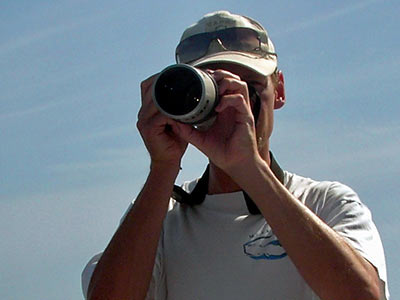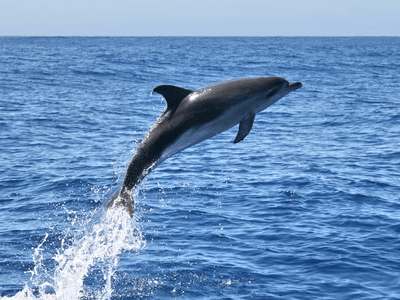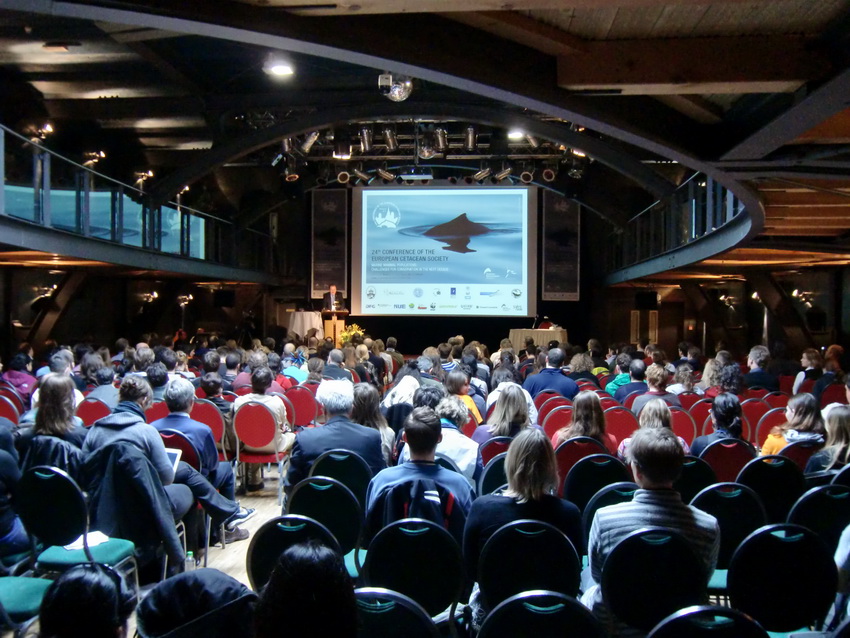Executive Summary
Interactions of Cetaceans with Whale Watching Boats – Implications for the Management of Whale Watching Tourism
Fabian Ritter / M.E.E.R. e.V., Bundesallee 123, 12161 Berlin, Germany. info@m-e-e-r.de
This report presents the results of cetacean research conducted 1995-2001 off the coast of La Gomera (Canary Islands). Data were collected during regular whale watching trips in the south and southwest of the island. The study was realised by cooperation of a tour operator and the German NGO M.E.E.R. e.V.
PART I.
In this part, cetacean abundance, distribution and their interactions with the whale watching boats are described. Eight behavioural units defined as boat-related (approach, scouting, bowriding, wake riding, spyhop, orientation towards the boat, accommodation of speed and accommodation of direction) were sampled. Additionally, sightings were categorised into avoidance, no response, proximity and interaction.
RESULTS
A total of 2,148 whale watching trips were conducted (8,935 hours of sighting effort). 21 cetacean species could be identified, and sightings generally peaked in springtime. Six species were sighted year-round: bottlenose dolphins (Tursiops truncatus, 35% of sightings), Atlantic spotted dolphins (Stenella frontalis, 17%), pilot whales (Globicephala macrorhynchus, 15%), rough-toothed dolphins (Steno bredanensis, 13%), striped dolphins (Stenella coeruleoalba, 3%) and dense beaked whales (Mesoplodon densirostris, 2%). Common dolphins (Delphinus delphis, 6%) were abundant seasonally, other cetaceans appeared irregularly. Mystecetes were seen predominantly, but not exclusively, during springtime and autumn. In summer and autumn of 1999, sei whales (Balaenoptera borealis) were present over a period of several months.
Seasonal and relative abundance of the most frequent species varied significantly between years. Whereas the numbers of sightings for bottlenose dolphins was constant, relative sighting numbers in the rough-toothed dolphin and the Atlantic spotted dolphin increased slightly. Common dolphin, striped dolphin and dense beaked whale sightings decreased though not significantly. Numbers of pilot whale sightings were heterogeneous with no noticeable trend over the five years period of observation.
1,680 behavioural samples (80.2 hours of observation) were analysed, comprising the six most abundant species. 268 sightings were categorised. Overall, the predominant types of boat-related behaviours were bowriding (41%) and approach (24%). The frequency of boat-related behaviours differed significantly between the species for all boat-related behaviours except scouting and spyhop. The predominant sighting categories were no response (35%) and proximity (31%). The frequency of sighting categories differed significantly between species.
Bottlenose dolphins showed a wide range of responses to boat presence. Their reaction was not predictable and strongly dependent on the actual behavioural state. Atlantic spotted dolphins interacted with boats more than all other cetaceans off La Gomera. Pilot whales in general were not attracted by boats, although they could be easily approached. Rough-toothed dolphins showed a marked ambiguity, sometimes being inquisitive, otherwise behaving quite reserved. The common dolphin in general appeared to be “open” to interactions with boats. Of all delphinids, striped dolphins were the least easy to approach and generally behaved warily. Sightings of beaked whales typically were short with the whales disappearing within minutes.
Relating the frequency of boat-related behaviours with behavioural states, the results were highly significant for the bottlenose dolphin and the Atlantic spotted dolphin. Bottlenose dolphins interacted more than expected during travel, and less than expected during dive and dive travel behaviours. In the spotted dolphin, during travel and milling the animals interacted more than expected and less during socialising and surface feeding. In the pilot whales, though results were not significant, during resting behaviour the animals interacted more with the boats than expected.
DISCUSSION
Especially during springtime, the waters off La Gomera congregate large numbers of cetaceans, leading to one of the highest species diversity reported world-wide. According to behaviours observed and the presence of juveniles and calves, the survey area constitutes a feeding and calving and/or nursing ground for bottlenose dolphins, pilot whales, Atlantic spotted, rough-toothed and common dolphins. Pilot whales sighted off La Gomera likely belong to a population off Tenerife straying to the neighbouring island(s) on a regular basis. The results strongly suggest residency for bottlenose and rough-toothed dolphins. Mysticetes seem to travel through Canarian waters during their southward movements.
Overall, the survey area represents an excellent habitat primarily for odontocetes. Oceanographic conditions off La Gomera appear to favour high productivity and hence provide a substantial prey availability for cetaceans, which probably is the driving force behind the higher abundance observed during springtime.
Cetacean species (re)acted differently in relation to whale watching boats, strongly suggesting that a species’ character is reflected by the way how the animals deal with vessel presence, i.e. the frequency of boat-related behaviours and the distribution of sighting categories. The increasing number of sightings of the more sociable Atlantic spotted dolphin thereby may indicate habituation to the whale watching boats, while the decreasing sighting numbers of dense beaked whales and striped dolphins (both species being more wary) over a period of several years might reveal a sensitisation process or reflect a decrease in the number of specimen. Thus, the different characters may strongly influence the species composition in the long term even in areas with low presence of whale watching tourism.
PART II.
On the basis of the results, recommendations for species-specific guidelines for boat-based whale watching are proposed. The likelihood of occurrence of boat-related behaviour in different cetacean species has been ranked in a list as a tool to enable whale watching skippers (and boat drivers in general) to evaluate which kind of interaction can be expected in a species and to accommodate the human conduct accordingly.
Our results also make it feasible to design refined guidelines taking into account different behaviours within a species, leading to the following recommendations: For Atlantic spotted and bottlenose dolphins, rules should be established recognising that feeding/foraging as well as social behaviours are critical activities which should be dealt with special care. Resting pilot whales should be left alone soon after the recognition of this behaviour. Other boats should be informed so as to pre-exclude the approach by more vessels. A cautious and attentive approach to rough-toothed dolphins (and other species) is likely to lead to a less wary behaviour of these animals.
Besides the dramatic development of the whale watching tourism in the Canaries, other environmental problems add to a critical situation of cetaceans in the archipelago: overfishing, pollutants and large amounts of waist in the sea, military activities, degradation of coastlines, high risk of collisions with fast ferries and acoustic pollution are but a few. Therefore, a comprehensive conservation status for whales and dolphins is a great need and the establishment of a marine protected area (MPA) is one of the most important goals.
To achieve ecological sustainability, the precautionary approach is essential in the field of marine mammal conservation and marine ecotourism. The principles of the precautionary approach comprise long-term economic benefit through responsible marketing, community engagement, public education, scientific research, continuing dialogue of all stakeholders, involvement of non-governmental organisations (NGOs), and the protection of natural resources through reasonable management.
PART III.
Integrating the findings and implications, a framework for a marine protected area (MPA) in the waters off La Gomera is presented. An MPA will raise the public awareness towards the uniqueness of La Gomera’s waters and will foster the recognition of whale watching as an attractive alternative source of income.
Numerous criteria applying to La Gomera’s waters – including species diversity, naturalness, importance for critical life processes (such as feeding, calving, nursing) and for local fisheries, productivity, and the economic, recreational and scientific value – contribute to the recommendation to establish a protected area mainly managed for the sustainable use of cetaceans (IUCN category VI). The primary goal is to protect these waters from excessive increase of whale watching tourism. The MPA shall be an instrument to bring different uses – above all fisheries, recreational use and whale watching – in line to establish a mutual co-existence, and not to exclude each other.
A model for the MPA is delineated. Concerning the regulation of user groups, the following propositions are made: the rights of locally based fisheries should be enhanced in the sense of exclusive fishing rights for professional fishermen. Big game fisheries and motorised sea-going fun sports should be completely relegated from the MPA. When together with cetaceans, precedence should be given to licensed whale watching boats over private vessels. Highest priority should be given to vessels with researchers on board.
When establishing a management plan, emphasis must be placed on the quality and sustainability of tourism. The intensity of whale watching activities must be regulated. It is recommended to allow a maximum of ten licensed whale watching vessels operating within the marine protected area. Vessel design should reduce negative impacts as much as possible (several practical measures are identified). The number of vessels approaching one group of cetaceans can be limited by the controlled issuing of licences, by dispersion of boats by time scale and through a system of land-based observation locations, the latter also serving to spot cetaceans and communicate sightings to whale watchers.
When creating a legal framework, it is strongly recommended to connect the issuing of licenses and permits to qualitative features of the whale watching trips, as there are: a) the obligation to present profound information before and during a trip, b) the obligation to collect sighting data on a regular basis and c) to regularly reserve a place for researchers to facilitate the collection of scientific data.
Principally, incentives should be emphasised to enforce legislation. The nomination of an “operator of the year”, acknowledging the amount and the quality of research and education presented, is but one idea. Other effective measures of enforcement are a) inspection boats, b) incognito observers on the vessels and c) monitoring from lookouts on elevated cliffs. Levies set aside as a fund for financing monitoring and enforcement should be included in the ticket prize.
Research must be an integrated part of every whale watching activity and should be multidisciplinary. It is strongly recommended to emphasise research projects using whale watching vessels as observation platforms, and to integrate volunteers and students. NGOs can play important roles in this process by providing expertise, education, personnel, and a vision.
It is essential to create a positive attitude towards an MPA among the local population through public education and local involvement. Highest priority should have the establishment of an interpretation centre on La Gomera. Other means to involve locals are surveys, the use of local media, organization of websites, events, well-prepared materials and free excursions offered to school children. Personnel should be recruited from the local population, too. Finally, a pleasant logo, presented on products, educative materials, etc. as well as on signs along the shore help to enhance the identification with the MPA.
A code of conduct should be established incorporating species-specific guidelines. Another central aspect is to realise a generally cautious approach. Avoiding and strongly interacting cetaceans should be left alone after a short period of time, whereas cetaceans showing no obvious reaction to the presence of a boat may accept longer sighting duration. Attention must always be directed to the percentage of calves and juveniles present in a group. Newborns should not be approached at all. Generally, when having difficulties to stay with the animals, the group should be left alone. Finally, no vessel should exceed the speed of 15 knots at any time within the MPA.
The project presented here proposes a fruitful linkage between tourism, scientific research, public education and conservation (i.e. between economic development and ecological sustainability). The use of whale watching vessels as platform of opportunity thereby were an excellent way to create the basis for scientifically based proposals for conservation and management. Existing political initiatives to protect the outstanding natural beauty of the Canary Islands thus shall be enhanced by a reconciliation of tourism and conservation.





